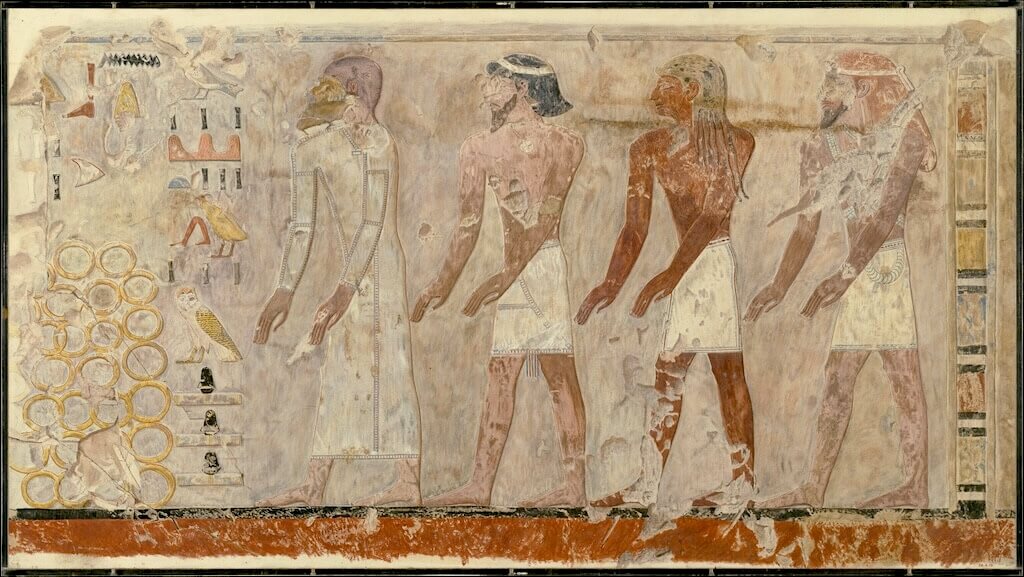
Ancient Near Eastern Rulers and their Delegations in 18th Dynasty Egyptian Tombs
June 2024 | Vol. 12.6
By Mohy-Eldin E. Abo-Eleaz
The victories of Pharaohs in their northern campaigns during the first half of the 18th Dynasty earned Egypt’s rulers entrance into a brotherhood of Great Kings who recognized Egypt’s great status. In the reign of Thutmose III, the kings of Babylonia, Cyprus, Assyria, and Ḫatti began to court the Pharaohs to strengthen their alliances. In the famous annals of Thutmose III, the arrival of the embassies to meet the king and his army, as well as the list of gifts carried by each of them, are presented as signs of respect from the donors, showing the sincerity of their intentions. Not only did such embassies communicate with Pharaohs while on campaign, but they also appear to have reached the Egyptian court with relative frequency.
Facsimile of a painting from the tomb of Puimre (TT39; reign of Thutmose III): Four foreign rulers show their respect at the Egyptian court. Painting by Norman de Garis Davies (1915), held by the Metropolitan Museum of Art (30.4.13). Public Domain.
The names of those countries were typically recorded in the royal annals. At the same time, Egyptian royal officials also bragged about these visits, memorializing the arrival of foreigners and their tribute through scenes in their tombs. A typical caption reads:
Giving praise to the Lord of the Two Lands, making obeisance to the Good God.… They extol the victory of his majesty, their gifts (ı̉nw) upon their backs, namely every product of God’s land: silver, gold, lapis lazuli, turquoise, and every precious stone so that the breath of life might be given to them. (Translation from E. Morris, Ancient Egyptian Imperialism (2018). John Wiley & Sons).
Foreigners are depicted in no less than fifteen private tombs from the 18th dynasty. The most frequent foreigners shown in these scenes are Levantines, Nubians, and the Aegeans. Within each register there is generally a hierarchical ordering of people and objects according to the Egyptian ideological worldview. At the front of the delegation is the most important figure, usually designated as “wr” in Egyptian, which is often translated into English loosely as “chief” or “prince”; it is thought that the wr is the local ruler. Following him are other men in varying attire. Behind the men are the women and children, who follow the animals that the men in front of them carry or lead on a leash.
Now, let us search for these foreign rulers in those scenes of the tombs of Thebes. In the tomb of Menkheperreseneb (TT 86), dated to the later reign of Thutmose III, there is a large scene depicting the occasion of the New Year’s Festival. The upper register is dedicated to the Syrian and Aegean figures. The first figure of the first register is prostrating and accompanied by a text identifying him as “chief of Keftiu wr n Kftjw” (Crete). The Annals of Thutmose III record Aegean diplomatic gift–giving in year 42, when the “Prince (wr) of Tanaja ” (the name used for the Greek land) sent silver and copper gifts. The following two figures are also Syrian figures identified by their accompanying texts as “chief of Ḫatti” (wr n Ḫt[ȝ]) and “chief of Tunip” (wr n ṭnpw).

Facsimile of a painting from the Tomb of Menkheperraseneb (TT86) depicting Aegean and Syrian rulers at the court of Thutmose III. The third figure from the left is the prince of Tunip presenting his son to the court. Painting by N. M. Davies, published in Ancient Egyptian Paintings Vol 1, Pl. 21. University of Chicago Press, 1936. Courtesy of the Institute for the Study of Ancient Cultures of the University of Chicago.
Also depicted in the scene above is the chief of Tunip bringing his son and presenting him to the court. One of the ways that Thutmose III endeavored to maintain control over his empire with a minimum use of force was by having chiefs bring/send their children and their brothers to be detainees in Egypt; and whenever any of these chiefs died, the Pharaoh would have the son/brother return home to assume his position. This practice was embraced by other late 18th–Dynasty rulers as well. Amenhotep III boasted of this practice, and the presence of foreign heirs at court is also attested in the Amarna archive.
Iamnedjeh, the “overseer of the gate” under Thutmose III, gave a prominent place in his tomb (TT 84) to the theme of foreign delegations. They are depicted presenting their gifts to the Pharaoh during the ceremonial appearance of the king in the palace of Heliopolis at “the beginning of the year” (tpy rnpt). The right-side of the wall commemorates in two registers the presentation of a Syria-Palestinian delegation to the gifts. One of the two prostrating figures of the lower register is named with the superscription as “chief of Naharin ” the most common Egyptian designation for the land of Mitanni).
In some other tombs, foreign ruler figures and their emissaries are represented bearing different objects and piling them in front of Egyptian officials themselves; this is attested in the tombs of Puimre (TT 39), Amenmose (TT 42), Sobekhotep (TT63), Senenmut (TT 71), Amenemheb (T T 85), Rekhmire (TT 100), Useramun (TT131), Intef (TT 155), and (TT119).
A chief from western Asia presents his son (fragmentary figure on right), preceded by a tribute bearer. Tomb of Sebekhotep (treasury official in the reign of Tuthmose IV). British Museum EA37987. © The Trustees of the British Museum.
Evidence dating to the late 18th Dynasty period is less abundant but continued to be celebrated during the reign of Akhenaten, even though this king has been criticized by many scholars for his negligence of foreign affairs. Two sets of scenes from the Amarna tombs of Meryra II (AT2) and Ḫuya (AT1) commemorate the gifts ceremony celebrated in the 12th regnal year of Akhenaten, whereby the king received foreign delegations from the Levant.
The depiction of foreigners at Akhenaten’s court indicated an interest in making his court appear cosmopolitan, and indicates continuity with the practices of his 18th dynasty predecessors. This is despite accusations of negligence by his Levantine vassals and the prevailing scholarly opinion that he lacked interest in foreign affairs.
It seems that this tradition continued until the end of the 18th Dynasty, as there is a scene of Libyan and Asian envoys bowing and scraping before Horemheb. However, after the end of the 18th dynasty, scenes of foreign chiefs and their delegates carrying gifts to the Egyptian king disappear from the repertoire of private tomb decoration.
Foreign envoys from Libya and the Near East bow and scrape before Horemheb. Relief from his tomb in Saqqara, ca. 1333–1323 BC. Photo courtesy of the National Museum of Antiquities, Leiden. CC0 license.
Mohy-Eldin E. Abo-Eleaz is Associate Professor of History and Civilization of Egypt and Ancient Near East at Minia University.
Further reading:
Abo-Eleaz, Mohy-Eldin E., 2019. Face to face: Meetings between the kings of Egypt, Ḫatti and their vassals in the Levant during the Late Bronze Age, Studien zur Altägyptischen Kultur 48: 1-21.
Abo-Eleaz, M.-E. E. 2021. “The reward of the pharaohs: Egyptian royal grants and gifts for the rulers of Canaan in the Amarna letters.” Antiguo Oriente 19: 65-112.
Anthony, F. B. 2016. Foreigners in ancient Egypt: Theban tomb paintings from the early Eighteenth Dynasty. Bloomsbury.
Panagiotopoulos, D. 2006. “Foreigners in Egypt in the time of Hatshepsut and Thutmose III.” In: Cline, E.H.; O’Connor, D. (eds.), Thutmose III. A new biography. University of Michigan Press, 370-412.
How to cite this article
Abo-Eleaz, M.-E. E. 2024. “Ancient Near Eastern Rulers and their Delegations in 18th Dynasty Egyptian Tombs.” The Ancient Near East Today 12.6. Accessed at: https://anetoday.org/abo-eleaz-egyptian-tombs/.
Want to learn more?
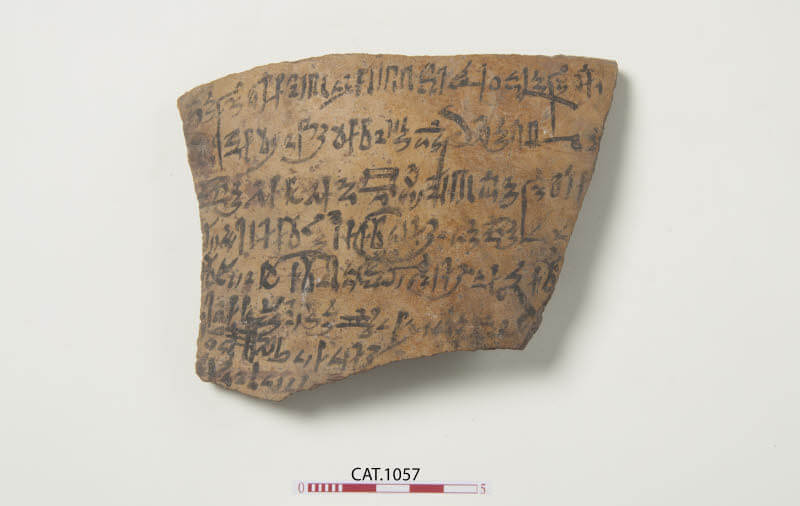
Osiris Must Die – Understanding the Practice of “Menacing the Gods” in Ancient Egyptian Magic
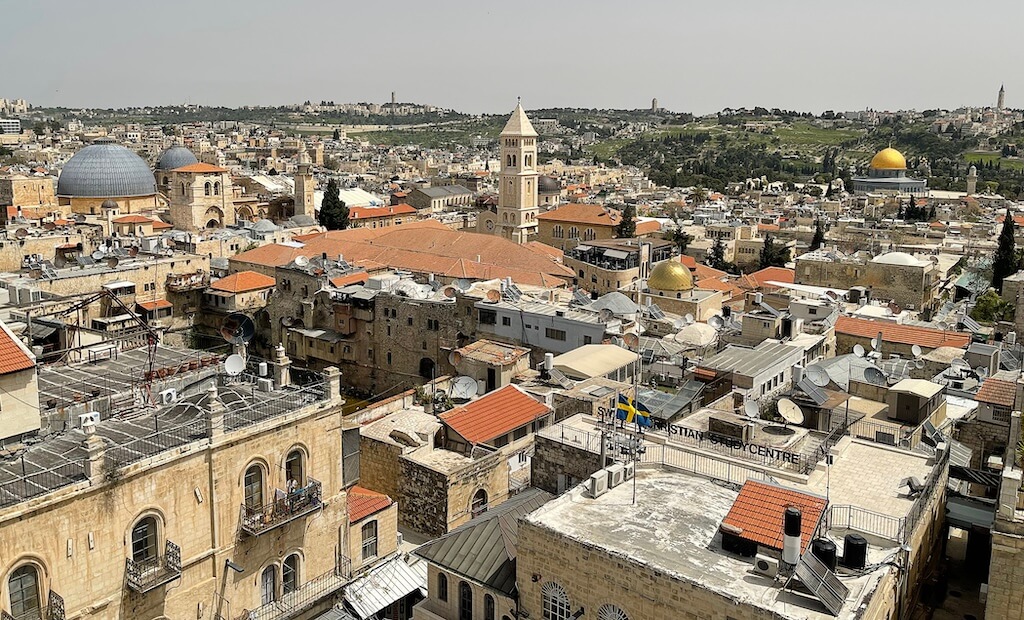
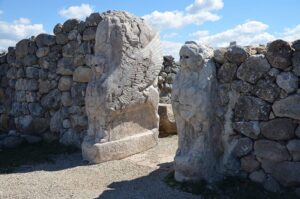
Resilience and Rebirth: Lessons Learned from the Aftermath of the Late Bronze Age Collapse
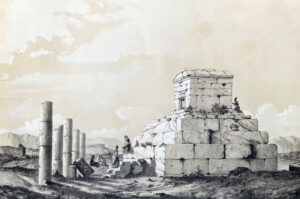

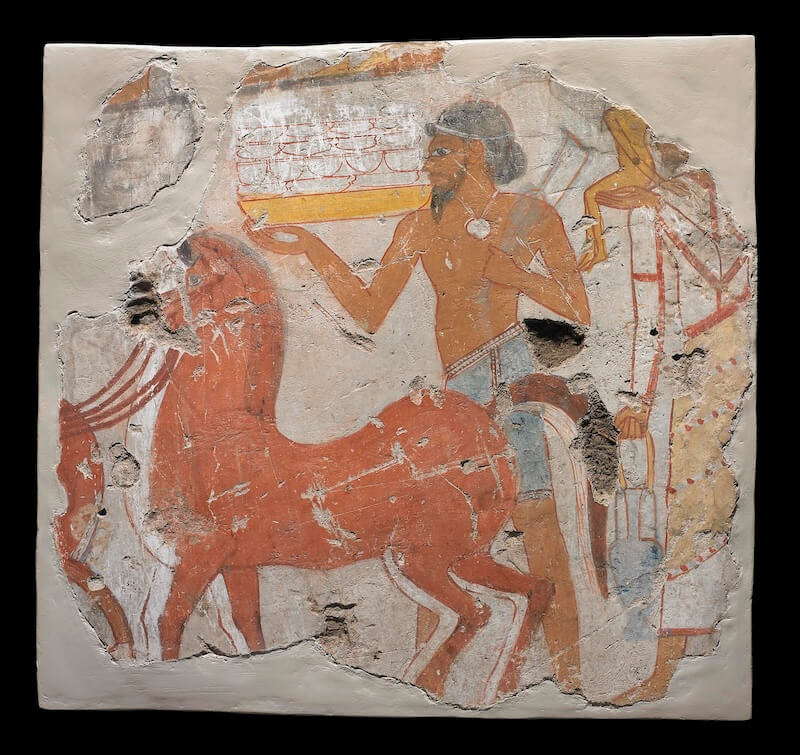

Post a comment